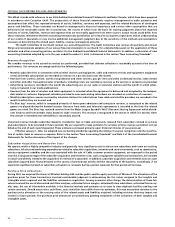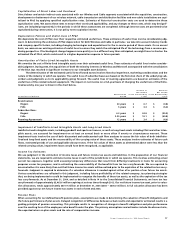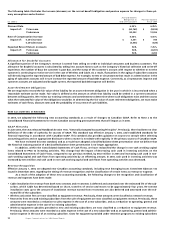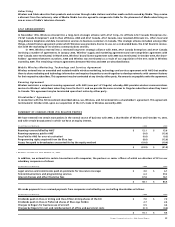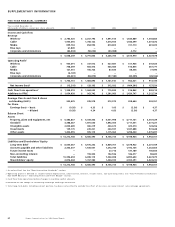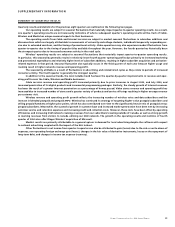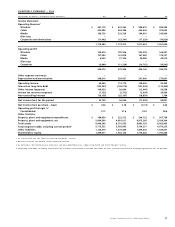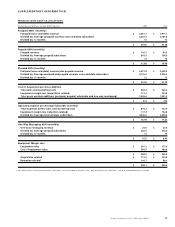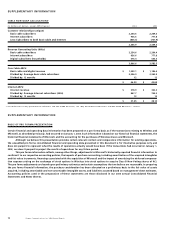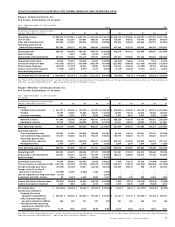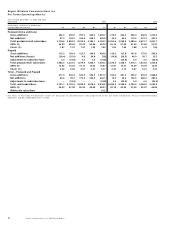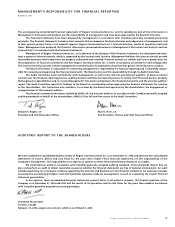Rogers 2004 Annual Report Download - page 67
Download and view the complete annual report
Please find page 67 of the 2004 Rogers annual report below. You can navigate through the pages in the report by either clicking on the pages listed below, or by using the keyword search tool below to find specific information within the annual report.
65
Rogers Communications Inc. 2004 Annual Report
SUPPLEMENTARY INFORMATION
SUMMARY OF QUARTERLY RESULTS
Quarterly results and statistics for the previous eight quarters are outlined on the following two pages.
Our operating results are subject to seasonal fluctuations that materially impact quarter-to-quarter operating results. As a result,
one quarter’s operating results are not necessarily indicative of what a subsequent quarter’s operating results will be. Each of Cable,
Wireless and Media has unique seasonal aspects to their businesses.
The operating results from Cable and Internet services are subject to modest seasonal fluctuations in subscriber additions and
disconnections which are largely attributable to movements of university and college students, individuals temporarily suspending ser-
vice due to extended vacations, and the timing of promotional activity. Video operations may also experience modest fluctuations from
quarter-to-quarter due to the timing of popular titles available throughout the year. However, the fourth quarter has historically been
the strongest quarter due to increased consumer activity in the retail cycle.
Wireless’ operating results are subject to seasonal fluctuations that materially impact quarter-to-quarter operating results.
In particular, this seasonality generally results in relatively lower fourth quarter operating profits due primarily to increased marketing
and promotional expenditures and relatively higher levels of subscriber additions, resulting in higher subscriber acquisition and activation-
related expenses in that period. Seasonal fluctuation also typically occurs in the third quarter of each year because higher usage and
roaming result in higher network revenue and operating profit.
The seasonality at Media is a result of fluctuations in advertising and related retail cycles as they relate to periods of increased
consumer activity. The fourth quarter is generally the strongest quarter.
In addition to the seasonal trends, the most notable trend has been the quarter-by-quarter improvements in revenue and oper-
ating profit across the Cable, Wireless and Media businesses.
Cable services revenue and operating profit increased primarily due to price increases in August 2003, and July 2004, and
increased penetration of its digital products and incremental programming packages. Similarly, the steady growth of Internet revenues
has been the result of a greater Internet penetration as a percentage of homes passed. Video stores revenue and operating profit has
increased due to increased number of stores and a greater variety of products and service offerings resulting in higher average revenue
per customer visit.
Wireless revenue and operating profit growth reflects the increasing number of wireless voice and data subscribers and the
increase in blended postpaid and prepaid ARPU. Wireless has continued its strategy of targeting higher-value postpaid subscribers and
selling prepaid handsets at higher price points, which has also contributed over time to the significantly heavier mix of postpaid versus
prepaid subscribers. Meanwhile, the successful growth in customer base and increased market penetration have been met by increasing
customer service and retention expenses and increasing credit and collection costs. However, these costs have been offset by operating
efficiencies and increasing GSM network roaming revenues from our subscribers traveling outside of Canada, as well as strong growth
in roaming revenues from visitors to Canada utilizing our GSM network. The growth in the operating results and statistics of fourth
quarter of 2004 also reflect Roger Wireless’ acquisition of Microcell.
Media’s results are primarily attributable to a general upturn in demand for local advertising despite the softness with respect
to national advertising coupled with the impact of the NHL lockout.
Other fluctuations in net income from quarter-to-quarter can also be attributed to gain (losses) due to the sale or write-down of
expenses, non-operating foreign exchange gain (losses), changes in the fair value of derivative instruments, losses on the repayment of
long-term debt, and changes in income tax expense (recovery).



